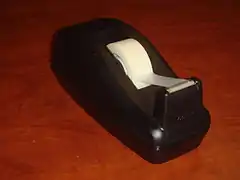Scotch Tape
Scotch Tape is a brand name used for pressure-sensitive tapes manufactured by 3M. Their magnetic recording tape products were also sold under the Scotch brand.


 Several packs of Scotch tape, including Magic tape on the right | |
| Product type | Pressure-sensitive tape |
|---|---|
| Owner | 3M |
| Country | St. Paul, Minnesota, U.S. |
| Introduced | 1930 |
| Website | scotchtape.com |
History
In 1930, Richard Drew, a 3M engineer, developed the first transparent sticky tape in St. Paul, Minnesota with material known as cellophane.[1] Drew's inspiration came from watching auto-engineers try to achieve smooth paintings on two-color cars. It was then that he created Scotch masking tape, and later evolved the product to be transparent. [2] In 1932, John A. Borden, also a 3M engineer, built the tape dispenser.[3] During the Great Depression, the versatility and durability of Scotch tape led to a surge in demand, as customers used it to mend household items like books, curtains, clothing, etc.[4] It had industrial applications as well: Goodyear used it to tape the inner supportive ribs of dirigibles to prevent corrosion. [2]
Trade names


Although it is a trademark and a brand name, Scotch tape is sometimes used as a generic term.[5][6] The Scotch brand includes many different constructions (backings, adhesives, etc.) and colors of tape.
The use of the term Scotch in the name was a pejorative meaning "parsimonious" in the 1920s and 1930s. The brand name Scotch came about around 1925 while Richard Drew was testing his first masking tape to determine how much adhesive he needed to add. The bodyshop painter became frustrated with the sample masking tape and exclaimed, "Take this tape back to those Scotch bosses of yours and tell them to put more adhesive on it!"[7][8] The name was soon applied to the entire line of 3M tapes.
Scotty McTape, a kilt-wearing cartoon boy, was the brand's mascot for two decades, first appearing in 1944.[9] The familiar tartan design, a take on the well-known Wallace tartan, was introduced in 1945.[9]
The Scotch brand, Scotch Tape and Magic Tape are registered trademarks of 3M. Besides using Scotch as a prefix in its brand names (Scotchgard, Scotchlite, and Scotch-Brite), the company also used the Scotch name for its (mainly professional) audiovisual magnetic tape products, until the early 1990s when the tapes were branded solely with the 3M logo.[10] In 1996, 3M exited the magnetic tape business, selling its assets to Quantegy (which is a spin-off of Ampex).
Magic tape
Magic Tape, also known as Magic Transparent Tape, is a brand within the Scotch Tape family of adhesive tapes made by 3M, sold in distinctive plaid packaging.
Invented and introduced in 1961, it is the original matte finish tape. It appears frosty on the roll, yet is invisible on paper. This quality makes it popular for gift-wrapping.[11] Magic Tape can be written upon with pen, pencil, or marker; comes in permanent and removable varieties; and resists drying out and yellowing.
In Japan, "Magic Tape" is a trademark of Kuraray for a hook-and-loop fastener system similar to Velcro. Instead the katakana version of the word Mending Tape is used, i.e., メンディングテープ, along with the familiar green and yellow tartan branding.
X-rays
In 1953, Soviet scientists showed that triboluminescence caused by peeling a roll of an unidentified Scotch brand tape in a vacuum can produce X-rays.[12] In 2008, American scientists performed an experiment that showed the rays can be strong enough to leave an X-ray image of a finger on photographic paper.[13]
References
- "Scotch US – History of Scotch Brand – From Tape to Tacky Glue, Laminator Machines and more" (PDF). 3m.com. Retrieved 28 March 2010.
- "Scotch Transparent Tape - National Historic Chemical Landmark". American Chemical Society. Retrieved 3 May 2020.
- inventions, Mary Bellis Inventions Expert Mary Bellis covered; films, inventors for ThoughtCo for 18 years She is known for her independent; documentaries; Alex, including one about; Bellis, er Graham Bell our editorial process Mary. "Meet the Banjo-Playing Engineer Who Invented Scotch Tape". ThoughtCo. Retrieved 3 May 2020.
- Matchar, Emily. "How the Invention of Scotch Tape Led to a Revolution in How Companies Managed Employees". Smithsonian Magazine. Retrieved 3 May 2020.
- Genericide: When a Brand Name Becomes Generic. Age of Persuasion: CBC Radio, 7 May 2011
- 15 Product Trademarks That Have Become Victims Of Genericization. Consumer Reports, 19 July 2014
- "Inventor of the Week: Archive". Web.mit.edu. Archived from the original on 3 April 2003. Retrieved 18 July 2013.
- Bellis, Mary. "The History of Scotch Tape". About.com. Retrieved 25 January 2013.
- "Scotch 75th Anniversary – The Tale of the Tape – Mad about Plaid". 3m.com. Retrieved 28 March 2010.
- "The Use of Metal and Plastic Reels with "Scotch" Sound Recording Tape" (PDF). Sound Talk. 3M. Retrieved 28 March 2010.
- An even less visible descendant of Magic Tape, Scotch GiftWrap Tape, was introduced in 1997.
- Karasev, V. V., Krotova, N. A. & Deryagin, B. W. Study of electronic emission during the stripping of a layer of high polymer from glass in a vacuum. (in Russian) Dokl. Akad. Nauk. SSSR 88, 777–780 (1953).
- Camara C. G., Escobar J. V., Hird J. R. and Putterman S. J., Correlation between nanosecond X-ray flashes and stick–slip friction in peeling tape, Nature 455, 1089–1092 (23 October 2008)
External links
| Look up scotch tape in Wiktionary, the free dictionary. |
- Scotch Tape in MNopedia, the Minnesota Encyclopedia
- History of Cellophane Tape and the Scotch Brand
- Scotch 75th Anniversary—Pages with history information and old commercials featuring Scotty McTape
- Scotch-tape.co.uk—Official website for the UK
- Scotchtape.com—Official website for the USA
- Ambidextrousmag.org—A brief history of tape
